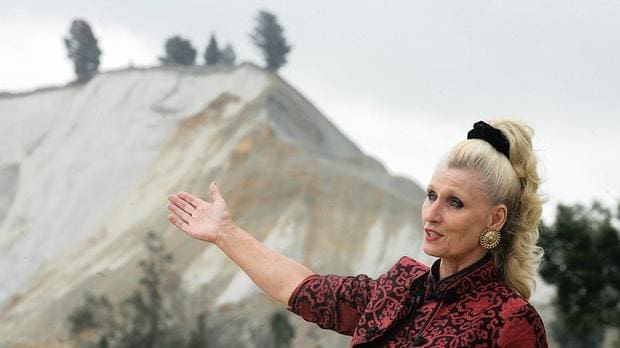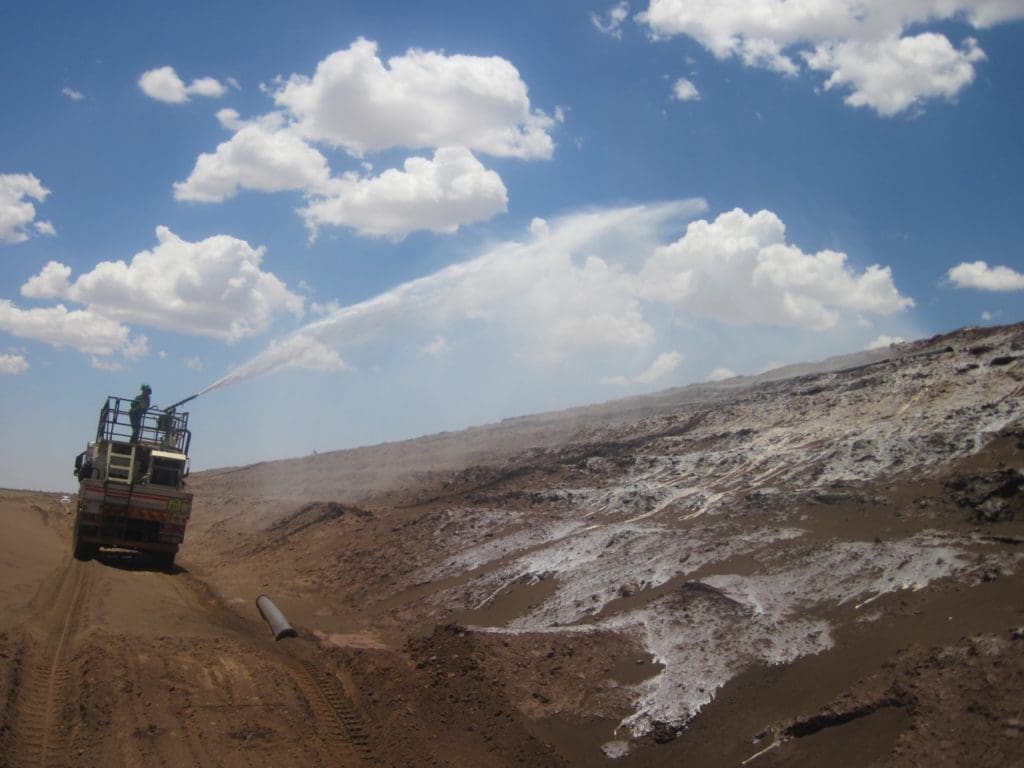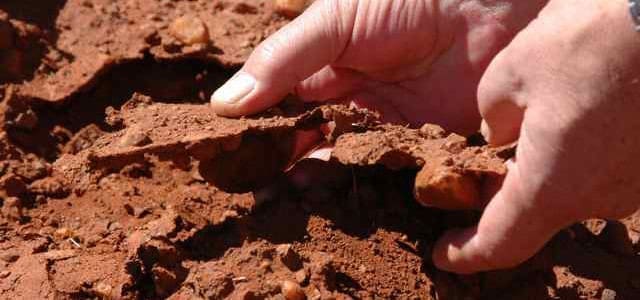Article Source. Bega, Sehree. IOL.co.za “Mintails mining created an ‘environmental catastrophe’ in the West Rand: https://www.iol.co.za/saturday-star/news/mintails-mining-created-an-environmental-catastrophe-in-the-west-rand-31578404
Johannesburg – As a heavy wind blows over the West Rand, clouds of dust swirl from clusters of barren mine dumps towering over both sides of Main Reef Road, turning the skyline a ghostly white.It’s a bleak scene that environmental justice activist Mariette Liefferink knows all too well.
“This is all Mintails’ and just look at how it’s been left,” says the chief executive of the non-profit Federation for a Sustainable Environment (FSE), gesturing to the unrehabilitated dumps.
She drives under a bridge, teetering over the busy road. The structure is collapsing from ongoing spillages during Mintails’ operations, she says.
But after a decade of government inaction against the Mintails Group, the FSE has now turned to the courts to deal with what Liefferink describes as one of South Africa’s “worst environmental catastrophes”, left behind by the liquidated gold mining and tailings processing company that was listed on the Australian Stock Exchange.
The FSE, represented by the Legal Resources Centre, has filed a landmark lawsuit against the Mintails Group, its liquidators, the ministers of Mineral Resources, Water and Sanitation, Trade and Industry, and Environmental Affairs as well as Mogale City local municipality in the North Gauteng High Court. In total, 34 respondents are cited in the litigation which seeks criminal charges against the firm’s directors.
In her founding affidavit, Liefferink warns how the mining activities of the “chronically poorly managed” firm spanning Krugersdorp and Randfontein will have “catastrophic consequences” for taxpayers, future generations, the natural environment and human health”.
Mintails applied for business rescue in October 2015, but was liquidated in September last year.
It has an unfunded environmental liability of R485million, but only around R25m financial provision in its environmental rehabilitation funds.
This will now be “externalised to the state, neighbouring mines, a mute environment, financially beleaguered local municipalities and communities characterised by widespread poverty and future generations”, reads her founding affidavit.
“The overall tab will be picked up by overburdened taxpayers who have little say in the ongoing corporate malevolence of the group.”
Liefferink details the firm’s “wholesale neglect” of its environmental responsibilities. This includes the “widespread abandoning of overseeing adequate and sufficient monitoring, mitigation, preservation, oversight, planning, and concurrent rehabilitation as part of their overall mining activities”.
It reclaimed only the profitable sections of the dumps, failing to rehabilitate any footprints.
“The Mintails Group have failed to complete the mining, removed the underground pillars (containing residual gold), failed to backfill and rehabilitate open pits and failed to secure the sites.
“Several polluted highly contaminated dams and open pits are easily accessible to school children, churchgoers and community members. These dams are toxic and potentially radioactive.
I’ve witnessed churchgoers being baptised in these toxic swell pools and children swimming in them on hot summer days. Certain people have died – the mining area is open and an exceptionally dangerous area to be in.
There is no signage, walling, fencing or lighting on the mined-out land and there has been “sporadic” dust control.
Polluted water from unrehabilated footprints and dumps has not been captured in lined pollution control dams. “The (firm’s) footprint has had a profound impact on surrounding wetlands as well as the catchment area. There have been ongoing spillages of acid mine drainage water and slurry, which has allowed acid mine water to seep from cracks in the pollution control dams into rivers and surrounding wetlands.
“There has been inadequate maintenance of the pipes and pollution control dams by the Mintails Group,” the affidavit reads.
Wetlands have become “potentially radioactive toxic dump lands” and the applicable mining area is now “ecologically dead”.
In 2009, the former Department of Water Affairs and the National Nuclear Regulator flagged Mintails for allowing acutely toxic water and slimes to migrate to the wetlands downstream of Lancaster Dam, part of the Wonderfonteinspruit catchment, the richest gold mining area in the world.
“The Wonderfonteinspruit is used for irrigation, watering of cattle, baptisms, recreational use, domestic use and at times for drinking purposes. It flows downstream into the Boskop Dam, supplying water to 400 000 people in Potchefstroom,” the affidavit reads. “That Lancaster Dam has been allowed to deteriorate in the manner it has by the Mintails operation presents a direct risk to life and limb.”
But the relevant state departments failed to enforce legally binding conditions for the firm’s mining and environmental reports.
The Department of Mineral Resources should never have afforded the firm the right to operate without the necessary financial provisions.
“The Mintails Group has over the years argued it will ‘top up’ the financial provisions during the life of mine. It was on this basis that the Mintails Group were granted certain mining rights The financial provision has not materialised at all and if any, the areas has been wholly unrehabilitated.”
The FSE wants the court to order the various ministers to remediate and rehabilitate the environment by enforcing current directives and compliance notices against the directors and to “recover” funds from them to clean up degraded sites.
“Some subsidiaries have ‘shifted’ assets and liabilities between subsidiaries. This includes shifting a mining right (asset) to one subsidiary, whereas the environmental liability associated with the activities of the mining right has been shifted to another subsidiary with the entity holding the liability falling under business rescue and liquidation,” the affidavit states.
“It needs to be investigated whether the dispositions in the Mintails Group, specific to shifting assets and liabilities and ‘moving’ an environmental liability in the region of hundreds of millions of rands, was done for value and whether this was done fraudulently, alternatively recklessly and further alternatively with an intent to defraud creditors.”
Liefferink details how the FSE has “literally begged” government departments to take action, “tirelessly submitting report after report” and conducting “well over 1 000” physical site inspections, to no avail.
“Despite issuing numerous pre-directives and directives and despite the FSE laying criminal charges (in 2014 against Mintails for non-compliance) the group and its board of directors in particular, have been allowed to carry on with business as usual.
“Without the relief sought, none of the roleplayers will even attempt to remediate and/or rehabilitate the environment. The sequence of events has been to to pass the buck, blame other departments and obfuscate.”
The state must “immediately do all things necessary, to cordon off affected mining areas and (ensure) safety mechanisms be adopted to safeguard the general public”.
“Indeed,” warns Liefferink, “people have already died and there exists an ongoing risk of poor public health, environmental catastrophe and even death regarding the areas and activities referred to, to the broader public.”
The Ministers of Minerals and Energy, Human Settlement, Water and Sanitation and the latter department’s deputy director general have indicated their intention to oppose the matter.
Liefferink says the FSE’s application is vital to address the governance of a company, “when the main benefactors of mining activities sit overseas and whereas the devastating consequences of their corporate greed is left to the poorest of the poor and overburdened taxpayers where the state has to intervene to prevent further degradation.
“The directors of Mintails need to be interrogated for their involvement in one of the country’s worst environmental catastrophes and to account to the public for their corporate decisions.”
Harmony Kalgold- SOUTH AFRICA
The client was looking for a cost effective environmentally compliant sustainable solution for dust abatement and erosion control on one of their stockpiles.
Assmang Khumani Iron Ore Mine Stockpile Treatment- SOUTH AFRICA
EBS Stockpile Treatment Proves Long-Term Dust Control & Erosion Prevention at ASSMANG Khumani Iron Ore Mine At ASSMANG Khumani Iron Ore Mine, a stockpile treatment using EBS Soil Stabilizer was conducted to demonstrate its effectiveness in dust control and erosion prevention. Two adjacent stockpiles were monitored: ✅
Eastplats Mine Tailings Application- SOUTH AFRICA
Eastern Platinum (Eastplats) Implements Long-Term Dust Control for Crocodile River Mine Eastern Platinum (Eastplats) Crocodile River Mine in South Africa required an immediate and effective solution for dust control on its Mine Tailings complex. The excessive dust was not only creating hazardous working conditions but also impacting
LOGIN / REGISTER
![]()
Stay Connected














